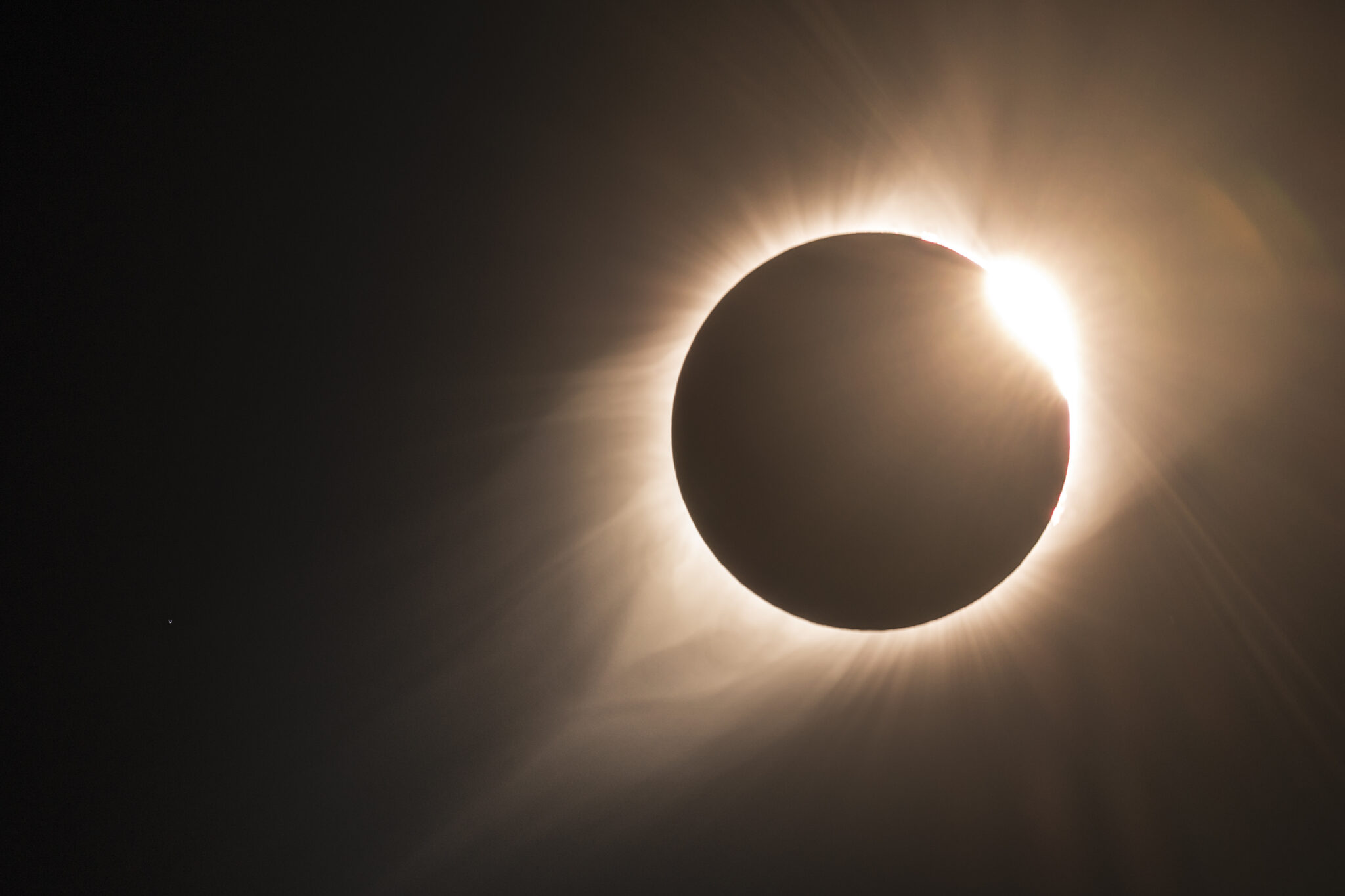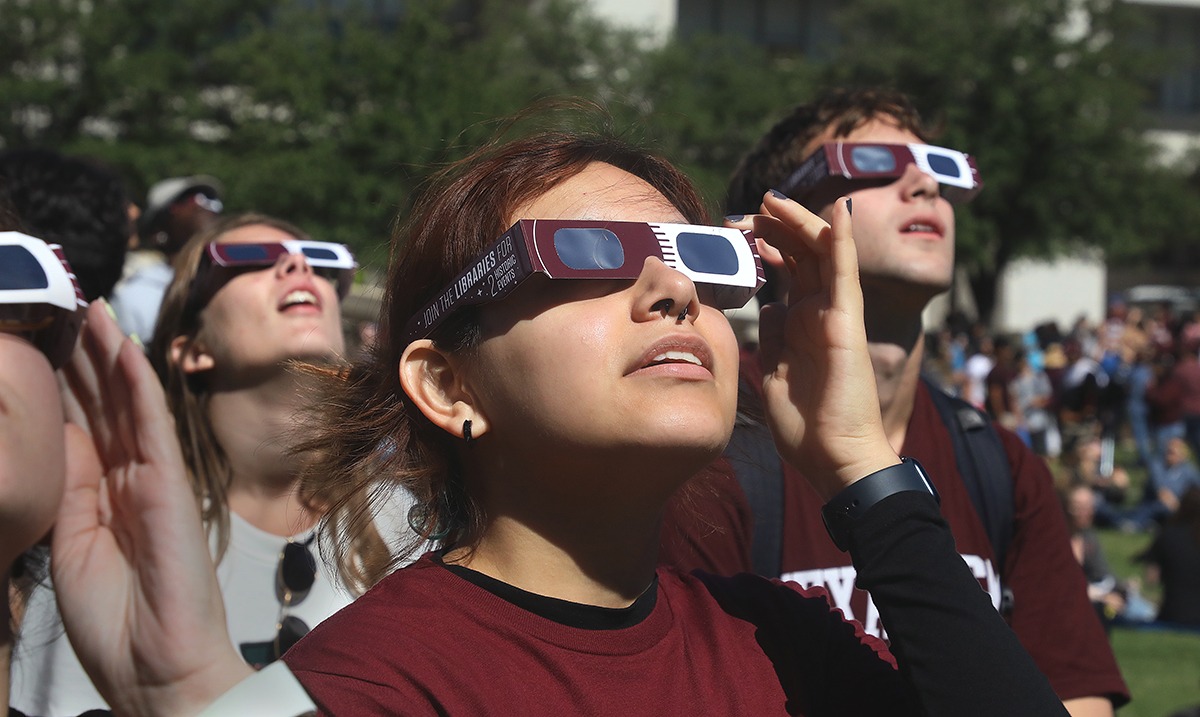
The last time the shadow of a total solar eclipse passed over the Lone Star State, it was the summer of 1878. Rutherford B. Hayes was president, and the Agricultural and Mechanical College of Texas had opened its doors to students just two years prior.
Plenty has changed since then, but the total eclipse on April 8 promises to be just as stunning as the one that captivated parts of Texas 146 years ago. For those lucky enough to see it in person, Texas A&M University astronomer Dr. Justin Spilker said the eclipse will offer “one of the most spectacular views that nature can provide here on Earth.”
If skies are clear, eclipse watchers within the roughly 100-mile-wide path of totality will get a rare glimpse of the sun’s white hot outer atmosphere, the corona, made up of ever-shifting strands of plasma stretching out into space.
“Normally this is completely invisible because the sun is so bright, so it’s only for those few minutes (when the moon covers the sun) that you can actually see it,” said Spilker, an assistant professor in the Department of Physics and Astronomy in the Texas A&M College of Arts and Sciences.
During that brief moment, things on Earth on will start to look and feel different, he said. For those under the moon’s shadow, “it will look like sunset in every direction around the horizon. You’ll notice the temperature gets colder by five to 10 degrees. Birds will start going to their nests, and crickets will start chirping because they think it’s night. Then, about four minutes later, the sun will emerge again.”
Just How Rare Is A Total Eclipse?
Two conditions must be met for a total solar eclipse to occur, said Instructional Associate Professor Emeritus of Physics and Astronomy Dr. Kevin Krisciunas: First, the moon must reach a point in its orbit where it appears to line up perfectly with the center of the sun when viewed from a specific spot. When the moon comes between the sun and Earth without this perfect alignment, it produces only a partial eclipse.
Second, the moon must be close enough to Earth to block out the entire sun. Any further away, and it will produce an annular eclipse, in which a thin ring of sun’s surface remains visible.
“Since the moon’s orbit is roughly elliptical, it’s not always the same distance from the Earth,” Krisciunas said. “And so sometimes when there’s an alignment, you have an annular eclipse, and sometimes you get a total eclipse.”
On one hand, total eclipses aren’t all that rare, Krisciunas said, with one occurring roughly every 1.5 years. On the other hand, he said, the path of these eclipses varies so significantly that it’s exceedingly rare for a given location to experience totality.
“Because the alignment of the moon and sun has to be so exact, usually you have to travel in order to seek this,” Krisciunas explained. “If you just stay home and wait for the path of totality to cover your house, on average in the northern hemisphere, you’ll have to wait 350 years between occurrences. If you’re in the southern hemisphere, it’s about once every 450 years.”
The fact that Earth experiences total eclipses at all is largely an “accident of fate,” Krisciunas said. On Mars, for example, both of the planet’s moons are too small and far away to cover the sun, making eclipses viewed from the Martian surface significantly less stunning.
While Earth’s moon is about 400 times smaller than the sun, it’s also about 400 times closer to Earth’s surface, allowing it to just barely cover the entire sun during a total eclipse, Krisciunas explained. However, this won’t always be the case, he said. Little by little, the moon is drifting further from the Earth. NASA estimates that in about 600 million years, it will be too far away to produce total eclipses.

When Is It Safe To Look At The Eclipse?
Those viewing the eclipse from outside the path of totality will need to use eye protection at all times when looking at the sun, Spilker said. Even when partially covered, the visible surface of the sun, the photosphere, emits an overwhelming amount of light — not just visible light, but infrared and ultraviolet light, too, he said. For those in the path of totality, the only time it is safe to view the eclipse with the naked eye is when the sun is completely covered and only the corona is visible.
“At that moment of totality, if you’re in the path, that’s when you can take off your glasses,” Spilker said. “Again, you can only take off your glasses if you’re within the path of totality, and I highly recommend that.”
Looking directly at the sun even briefly can do lasting damage to the retina, the layer of photosensitive cells lining the back inside wall of the eye. Crucially, Krisciunas said, this part of the body is not capable of registering pain, meaning it’s possible to damage to the retinas without noticing it until later.
Some safe ways to view the eclipse include indirect methods like a simple pinhole camera or a telescope oriented to project the sun’s image onto a piece of paper. If looking directly at the sun, use a pair of eclipse glasses or similar viewing devices that meet the ISO 12312-2 standard.
“If you have a pair of eclipse glasses, it should say that number on there somewhere,” Spilker said. “If you put them on, you should not be able to see anything except the sun.”
Binoculars and telescopes should be fitted with similar specialized filters when used for direct viewing. The same goes for cameras and camera phones, Spilker said, though he argues it’s best to experience the eclipse with as few distractions as possible.
“Especially during the moments of totality, I would not recommend trying to take pictures,” he said. “It’s a surreal, otherworldly experience, and it lasts for a very short time. So I would recommend that unless you are an expert in photography, live in the moment and experience that to the fullest.”
Prepare To Be Amazed
Eclipse watchers should also keep a close eye on the edge of the moon immediately before and after totality, Spilker said. For a few brief moments, sunlight will seep through mountain ranges and other topographical features on the moon’s surface, producing a visual phenomenon known as “Baily’s beads.”
“You’ll start to see glints of sunlight that look kind of like a diamond ring, where you’ll have the corona around the outside and then a flash of bright light in one particular place,” Spilker said.

According to Krisciunas, the experience of watching a total eclipse can be difficult to explain, though plenty of people have tried. One description that best captures “the mystery of the whole thing,” he said, is a verse from the seventh century BCE, in which the Greek poet Archilochus remarks: “Nothing can be surprising anymore, or impossible, or miraculous, now that Zeus, father of the Olympians, has made night out of noonday.”
While humanity’s understanding of the cosmos has evolved significantly since then, Krisciunas said those who find themselves under the moon’s shadow on Monday will likely experience that same sense of awe as the sky slowly turns dark.
“You’re looking up, and the sun is unlike you’ve ever seen it,” he said. “It’s a phenomenon of nature that if you have a chance, you really should see at least once.”
This story was originally published by Texas A&M Today.
